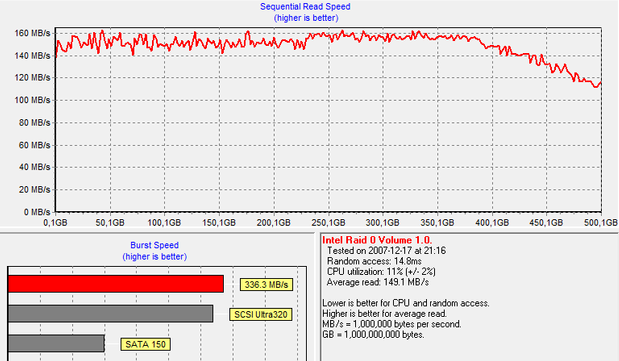How do I enable it? This is a relatively simple operation. You should run Intel's matrix management program under Windows, called Intel Matrix Storage Console. Then, in the View, select Advanced Mode to get more detailed information on our matrix. The next step is to choose the Volumes our matrix by right-clicking. You will see a menu from which you select Enabled Volume Write-Back Cache. And here's the way we have write caching enabled. The whole operation shows us this screen shot.
Please visit InfoRecovery - raid disk recovery.
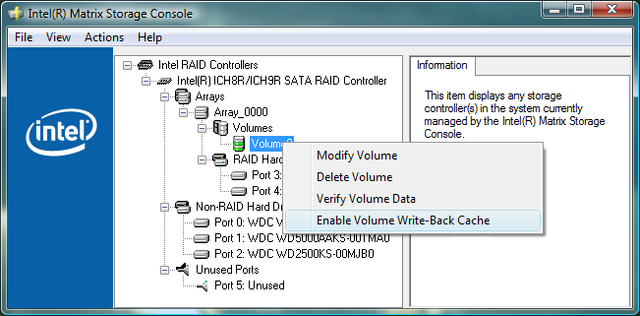
When you enable the effect of its action is immediate, it is not even required a system reboot. Now that we know how to enable this option - it's time to test to see what it gives us. Tests will be conducted in the three most popular programs of testing hard drive performance. In each of these tests will be performed with both enabled and disabled the option "Write-Back Cache".
HD Tach RAID 0 Long Write-Back OFF:
HD Tach RAID 0 Long Write-Back ON:
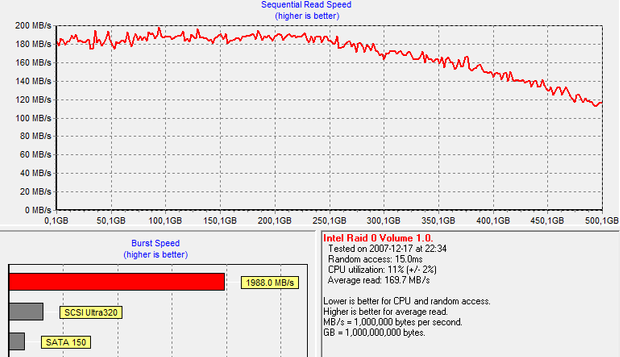
Traditionally the first program to HD Tach. As seen in the screenshots above average reading has increased by considerable 20MB / s For this value of Burst Speed increased many times, what is the effect of caching. This will be visible in all the test programs. In addition, I want to point out that the Burst Speed does not translate into a significant effect on performance of our matrix!
Everest WB OFF - Read Test Suite - RAID 0:

Everest WB ON - Read Test Suite - RAID 0:

If this option is not had much experience on Everest testing program. Buffered Read Only option, as it was in HD Tach burst speed of the option has increased many times. The rest of the results were virtually the same.
HD Tune WB OFF - Benchmark - RAID 0:
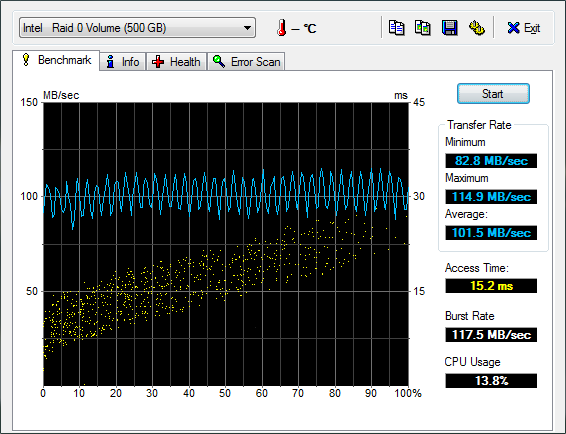
HD Tune WB ON - Benchmark - RAID 0:
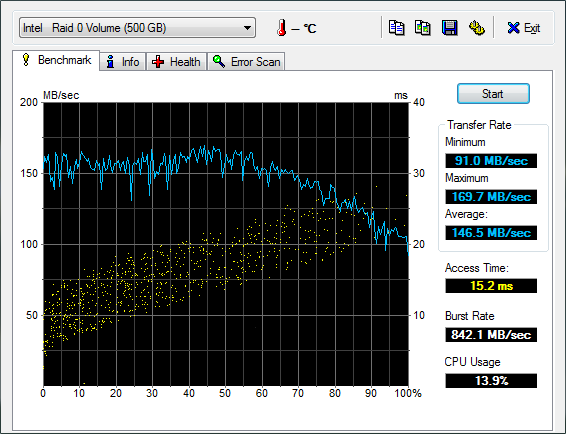
While in the HD Tune virtually all the results have improved significantly, especially average reading, which increased by 40MB / s! What is a great value! Both the minimum and maximum value in the test were significantly improved and, as it was in HD Tach, and Everest, the burst rate has also increased. Outside of Test programs can also be noted the increase in performance when copying between partitions of the matrix or within the same partition on the array. Productivity growth is closely linked to the disks used to construction of a matrix version of the drivers and the corresponding controller for RAID. The increase in starts with an average of 5MB/sw up, and in extreme cases may even amount to 40MB / s, which makes it worthwhile to be interested in this option.
You can visit our office with RAID data recovery in Salt Lake City
"Write-Back Cache" and data security?
On the Internet you can read many reviews about the dangers posed by the inclusion of this option. Most of them are unsupported by any facts, conjecture and presumption of user groups. He decided to see how these opinions relate to reality and to carry out a number of quite brutal tests. Of course, all for scientific purposes. ;) The "write-back cache," as each write caching involves some risk and is not subject to discussion. The main purpose of the test is just to verify that it is so great, how many people it describes! Only word access, the time for test.
All tests were performed on the ICH8R RAID 0, two drives ST3250410AS 7200.10 250GB 16MB SATA2, under Windows 7 x86.
Test No1.
Hard reset on startup - each in more or less elsewhere. Right at the beginning just before the progress bar during the show and right after him. Each time the system got up without a problem by displaying only the information that the last system is not properly closed. After selecting Start Normally, the system started as usual without any problems.
Test No2.
Hard resets Windows operating system. The first show took place at the desktop, another while viewing system options, and the last when viewing the system partition. Just as it did in the previous test, except the message about improper shutdown, nothing more has happened.
Test No3.
Hard reset the system after copying the AVI file size of 700MB with another disk. After restarting the system file had the correct amount to give open and run without problems. A similar situation with a few hundred megabytes of JPG files.
Test No4.
Hard reset when you copy the AVI file size of 700MB from another disk - after rebooting the system file had the correct size, but it did not work, which is not surprising, but what it is worth adding gave the normally clear. JPG files are copied to the time when you pressed the reset were intact on the RAID array except the last, where she was only half the picture, which is also not unusual.
Test No5.
Copying within the matrix. Similar situation occurred here, as in the above tests, so there is too much of what I write too much. The other hand, it is worth adding that the data that was copied from the source location were not damaged.
Summary:
All these tests abolished matrix without problems, did not show instability in spite of a rather brutal treatment by the user. ;) There were no errors, interruptions in the matrix of data that are, or damage your system. In summary infamous reputation, which was christened the option "Write-Back Cache" is a little exaggerated, and its inclusion is not equal to the immediate loss of data during an unplanned power failure or system crash, but still be aware of this possibility!
Warning:
Description of Write-Back option and the following comments apply only write operations! Additionally, be aware that a sudden power failure or system crash during a write operation always results in the loss of a certain amount of data, I repeat always! For the fact of data loss does not matter whether the drive was working alone or in arrays, or with enabled write-back. The title option alone can increase the amount of data lost due to write caching. Disabling this option can only reduce potential losses, but not eliminate them! In most cases, but they are small and almost imperceptible loss. In everyday use can result in damage to a mostly photographs or video file, with which the average user in the vast majority of cases can be reconciled, the situation is worse in cases where a failure occurred while saving your system settings. In this case, it may even lead to damage to the system!



